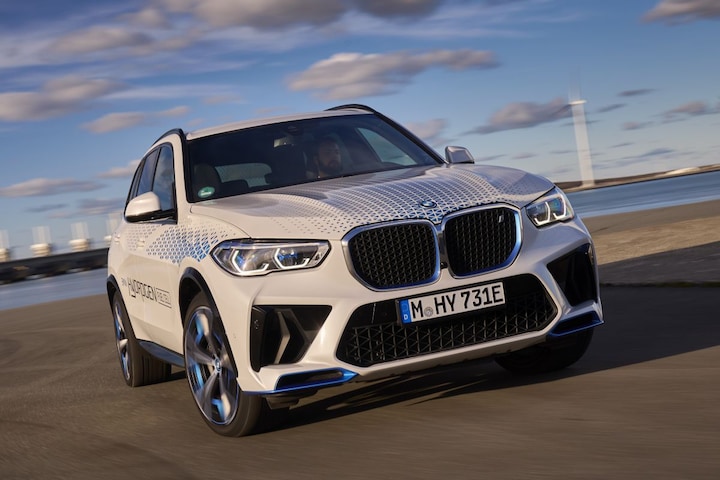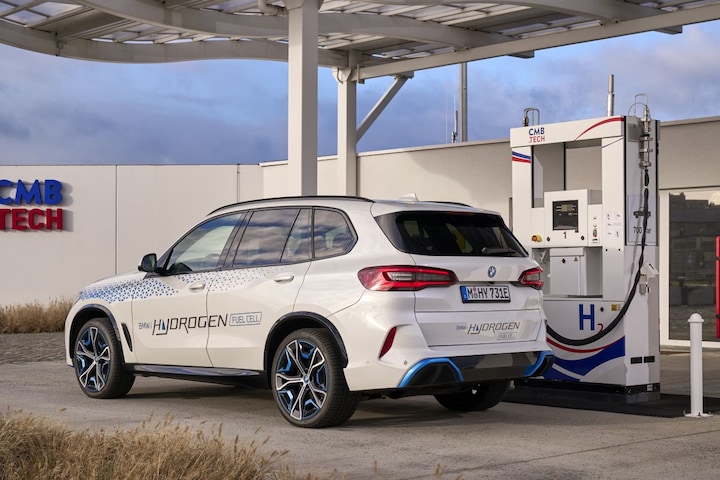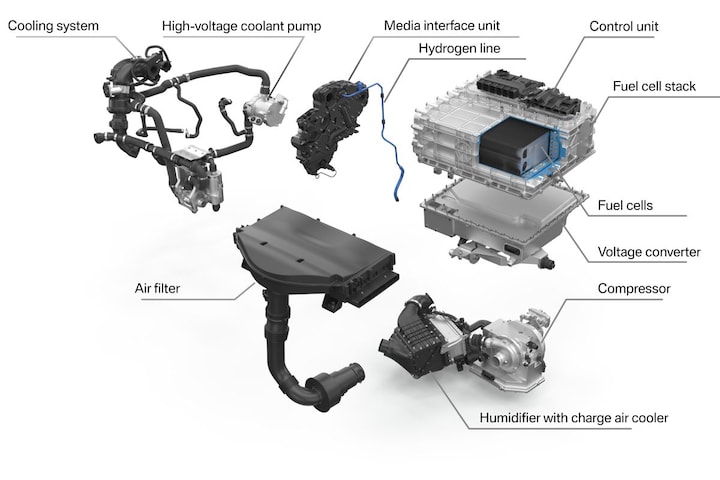Just as promising a testing ground as the Mini E of fifteen years ago?

BMW is preparing for several tracks, because in addition to the battery-electric car, they also see a future for the hydrogen car in Munich. We are already introduced to one of the iX5 Hydrogens from a small test series. Is this just as promising a testing ground as the Mini E of fifteen years ago?
BMW uses a V12 for its hydrogen cars, right?
Yes, but that was almost twenty years ago. For a worldwide field test with hydrogen, BMW is now building a test series of just under a hundred fuel cell cars. The first copies are already on the road and we have been on the road with one of them: the BMW iX5 Hydrogen. This is an SUV equipped with a fuel cell that feeds an electric motor. Anyone who has followed BMW’s hydrogen activities will probably find the use of this technology remarkable. Twenty years ago, we drove an experimental 7-series at BMW, the V12 of which ran on hydrogen. Unlike Mercedes-Benz, BMW did not see anything in fuel cells at the time.
Now we hardly see hydrogen passenger cars with a combustion engine anywhere. There is also a reason in Munich that they have stopped using hydrogen combustion engines. “With a fuel cell, clean water comes out of the exhaust, nothing else. In an internal combustion engine, there are also leftovers of engine oil. In addition, nitrogen oxides can be formed during the combustion process: at high temperatures, the harmless nitrogen in the air reacts with the oxygen in the air. You will then meet your CO2 targets (after all, hydrogen is not a hydrocarbon, ed.), but it is not zero emission.”

Twenty years ago, a hydrogen BMW was a limousine with a V12, now an SUV with an electric motor.
Is driving on hydrogen more efficient than driving electrically?
No. Hydrogen is not an energy source but an energy carrier, it must be produced and that costs energy. But nowadays it is possible to make green hydrogen on a serious scale via electrolysis, based on green electricity. Energy is lost during that production, but they see advantages at BMW: “To cover a distance with a fuel cell car, you need up to two and a half times as much electricity as when you cover that distance with a BEV. Cause: the losses during the production of hydrogen, the physical distribution and the efficiency of the fuel cell. So you need up to two and a half times as many windmills, solar panels or hydroelectric power stations. On the other hand, energy companies sometimes cannot sell their electricity, even if they admit money.”
The production of hydrogen can be a solution to absorb such fluctuations. Not only for passenger traffic, but also for freight traffic: an electric truck needs about 1,000 kilos of batteries per 100 kilometers of range. This is still manageable for distribution traffic, but it will be different for international transport. A battery-electric truck then has little charging capacity left. In addition, hydrogen can be a solution for aviation and industry.

When wind turbines cannot lose their electricity, H2 production is a serious option.
Who is the hydrogen car intended for?
At BMW they do not see the fuel cell car as a replacement for the BEV, both have a right to exist: “The FCEV is a solution for motorists who do not have easy access to a charging point, who often need the car and want great flexibility, who live in a cold climate or who regularly have to travel with a trailer.” Then there is the issue of raw materials. The basic components of a battery – cobalt and lithium – often come from countries on which we do not like to depend. In addition, these substances are not always extracted under the best conditions. So if you care about the fate of the people in the mines: the compact battery pack of the iX5 Hydrogen requires less than ten percent of the cobalt and lithium of the battery pack of an equivalent BEV. Platinum is needed for the fuel cells, only a few tens of grams per car. Much of it can be reused from catalytic converters that are still in gasoline-powered cars today; 99 percent of the platinum from a catalytic converter can be recycled. For a fuel cell stack you need as much platinum as we can extract from two catalysts.

In the cold, hydrogen is more useful than batteries.
How does the BMW iX5 Hydrogen actually work?
Unlike a flat battery pack, a thick, round hydrogen tank does not fit under the floor of a car. That’s why BMW uses an X5 and not an existing EV. The X5 has a large cardan tunnel and it fits such a tank. There is also a second, slightly smaller tank under the rear seat. Together they provide a range of more than 500 kilometers. Under the floor of the luggage compartment is the 401 hp electric motor, technically the same as in the back of the iX and i7, together with the power electronics and the high-voltage battery. Under the hood we find fuel cell technology. BMW cooperates with Toyota in various areas. For example, you will find the same cells in the fuel cell stack as in the Toyota Mirai, only the iX5 has a lot more. BMW has developed the rest itself, such as the air filter, the electric turbo, the intercooler with humidifier, the voltage converter and all associated electronics. The turbo (air bearings, because no oil is allowed to enter the fuel cell) is not only driven by the exhaust fumes, but also works electrically, so that there is always enough air in the fuel cell.

The fuel cell technology is located in the front, the electric motor in the back and the hydrogen tanks in between.
Is the fuel cell always working?
No. The electric motor sometimes only receives its power from the fuel cell, sometimes only from the battery and sometimes from both. The capacity of the battery is quite modest and you cannot charge it with a cable. However, it can deliver a relatively large amount of current and therefore a lot of power, and that is what this thick BMW is all about. The efficiency of fuel cells depends on the load. It does best at about a third of the maximum power, then the efficiency is between 60 and 65 percent. If you step on the accelerator more deeply, it becomes less efficient, down to just under 50 percent at full power. Because the efficiency also drops slightly at a lower load, i.e. at less than a third of the maximum, the car in Eco sometimes drives long distances on the battery alone. The fuel cell is then switched off.
In Sport mode, we always drive on the fuel cell, so that when you step on the accelerator, extra electricity is immediately available from the battery. Otherwise it wouldn’t work spontaneously enough. The fuel cell needs some time to get up to full steam. Not much, less than a second, but that’s not what you want, especially with a BMW in Sport mode.

Like a combustion engine, a fuel cell is not always efficient.
How does that drive, such an X5 on hydrogen?
BMW has a reputation to uphold when it comes to dynamics. With the iX5 Hydrogen that turns out to be perfectly fine. It is that the instrumentation is equipped with a temperature and a tank gauge (and that we refueled it ourselves), otherwise you could just think that you are on the road with a BEV. The car reacts as spontaneously as a battery-electric BMW and does its job in the same silence.
At BMW they are now looking at the optimal number of cells in the stack. Not so much for a higher power, but when you have more cells, you do not have to load them intensively and you also have a more favorable return when a lot of power is required. But yes, a larger number of cells does come with a price tag. They have to find a balance in that.
BMW is in the same phase with the fuel cell car as it was at the time with the large field tests with the Mini E and the 1-series ActiveE in the run-up to the i3, BMW’s first electric series product. The iX5 makes a mature impression and is more practical than the 2008 Mini E, which had to do without a back seat. That extensive testing period lasted about five years at the time. Or does that mean that you can buy a hydrogen car from BMW within five years? They do not want to confirm or deny that at BMW.

The interior of the BMW iX5 Hydrogen is just as spacious as that of a regular X5.
.
– Thanks for information from Autoweek.nl